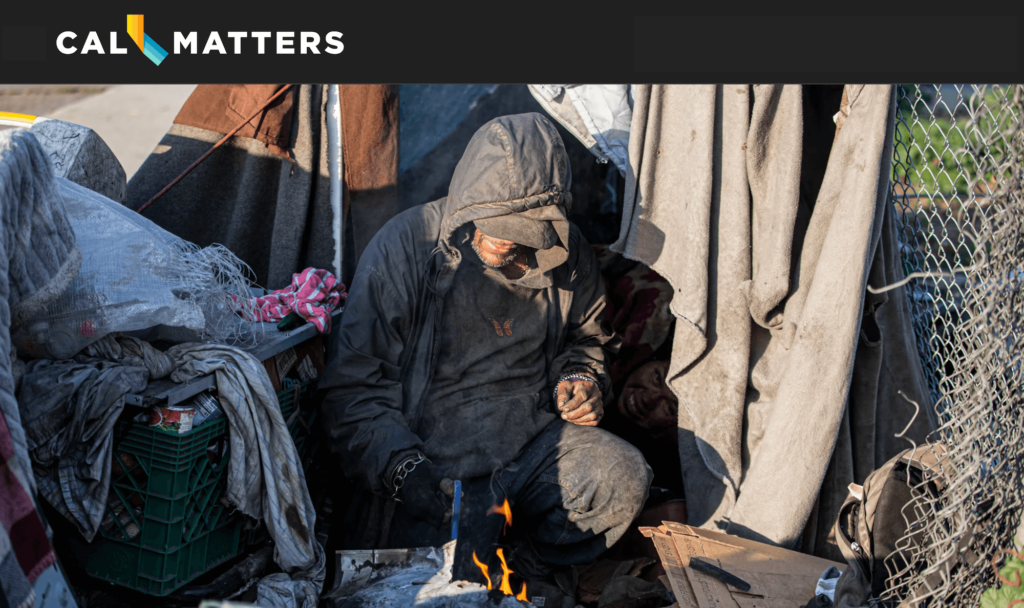This article was originally published in Cal Matters.
For many people, living on the streets of California is a death sentence.
That’s according to a recent study that took the first deep look into mortality rates in homeless communities throughout the country. It found the death rate more than tripled between 2011 and 2020. The findings make it clear that at the same time the number of homeless Californians is soaring, it’s also becoming more dangerous to be homeless. And it means the stakes are sky-high when it comes to state and local efforts to combat the crisis: People’s lives are on the line.
The study’s co-author, Matthew Fowle of the University of Pennsylvania, said the 238% increase was “astonishing.”
“It’s unlike any other mortality trend that we really see in demography,” he said. “It’s comparable to something like a natural disaster or war.”
Overdoses played a major role in the deaths studied. But people also are dying at increased rates of things that might be avoided if they had a home or regular access to preventative medical care, such as heat and cold exposure, traffic injuries, cardiovascular disease and diabetes.
“It’s just so hard to do that when you’re living on the streets or living in a shelter,” Fowle said. “Your main concern is, ‘Can I stay warm and dry for the night? Can I get enough food to eat?’ You can’t think about these other longer-term things that might be affecting your health until, in many cases, it’s too late.”
Some of the increase in the mortality rate may be attributable to county death records keeping better track of who is homeless, Fowle said. Other than that, he and his team aren’t sure what else is behind the rising death rates — more research is needed, he said.
“Clearly something is occurring across the country,” Fowle said.
The study, published this month in health policy research journal Health Affairs, appears to be the first to look at death rates and causes of death in homeless communities nationwide. Data on this subject is spotty, as the feds and most states (including California) don’t require medical examiners to list someone’s housing status in their death records. Fowle’s study looked at 22,143 deaths of homeless residents in 22 localities across 10 states and Washington, D.C. — including eight California counties. The death rate across all 22 localities increased from 814 per 100,000 homeless residents in 2011, to 2,752 per 100,000 homeless residents in 2020.
Among the general population, the nationwide mortality rate was much lower: 1,027 deaths per 100,000 people in 2020, according to the Centers for Disease Control and Prevention.
In California, the study looked at Alameda, Los Angeles, Orange, Sacramento, San Diego, San Mateo, Santa Clara and Solano counties. In those counties, the mortality rate more than doubled between 2015 and 2020. Some of those counties didn’t start collecting data until 2015.
Like most information on unhoused populations, the data has limitations. For example, it uses mortality rates based on the federally mandated point-in-time population counts, which are inexact estimates of the country’s homeless communities.
Nationwide, drug and alcohol overdoses were the leading cause of fatalities, accounting for nearly a third of all deaths. Overdoses caused 986 deaths per 100,000 unhoused people in 2020, a 488% increase from 2011.
The opioid crisis and the increased prevalence of fentanyl played a huge role in those numbers, said Fowle, a postdoctoral fellow at the University of Pennsylvania’s Housing Initiative at Penn. But deaths also may be driven by new efforts throughout California and beyond to crack down on people sleeping in public places, he said. When people use drugs in a homeless encampment surrounded by people they know and trust, or even alone on a busy downtown street, there’s a greater chance someone will see them and intervene if they overdose. If law enforcement breaks up their camp and pushes them out of downtown, they often go to isolated areas such as creek beds, where they’re harder to help in an emergency.
When someone is displaced from their camp, they also become less able to access a safe supply of drugs — putting them at greater risk for consuming something laced with fentanyl, said Dr. Margot Kushel, director of the UCSF Benioff Homelessness and Housing Initiative.
Another reason being homeless has become more deadly? The homeless population is getting older, Kushel said.
The number of Californians 55 and older who sought homelessness services soared 84% between 2017 and 2021, according to the state’s Homeless Data Integration System. That’s compared to a 43% increase across all age groups. People become homeless for the first time after age 50 with more frequency now.
“As the homeless population continues to age, you’re just going to see death rates keep going up and up and up,” Kushel said. “You expect that, and it’s horrendous.”
The average age of death in the University of Pennsylvania study was 51 — more than 27 years younger than the average U.S. life expectancy during that time period.
Deaths attributed to cardiovascular disease, the second-leading cause of death, increased 172% between 2011 and 2020. Other causes that saw major increases include diabetes, infection, cancer, homicide and exposure.
Being homeless is incredibly bad for your health, Kushel said. As soon as someone loses their housing, everything else starts to fall apart. Drug use tends to get worse, people lose the medication that treats their chronic illnesses, and they don’t go to the doctor for preventative care because they’re too busy worrying about where they’ll sleep or what they’ll eat. That means something like a small infection can turn life-threatening quickly.
And once someone is diagnosed with a serious illness, treatment is much harder on the street. A recent study of veterans with cancer, co-authored by Kushel, found that those without housing were 10% to 20% more likely to die than those with housing. Even for veterans who started out homeless during the study, once they found housing, their risk of dying plummeted.
“There is increasing evidence that you can prevent a lot of these deaths just by getting people housed,” Kushel said.
Clinicians who treat people on the street are watching in real time as conditions for their patients become more deadly. Whenever outreach workers call Dr. Susan Partovi, medical director of Homeless Health Care Los Angeles and author of the memoir Renegade MD, the first thing she asks is “Who died?”
All too often, it’s someone she knew.
“It’s really heartbreaking,” she said, “when you know someone, and you know their humor, and you know their dreams, and you know their past history, and you know their ups and downs in life…And you’re kind of in the trenches with them and their struggles. And then they die. It’s just so disheartening. It’s just so sad.”

